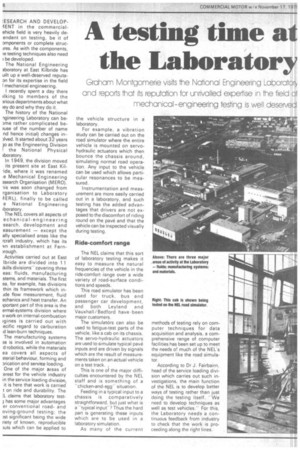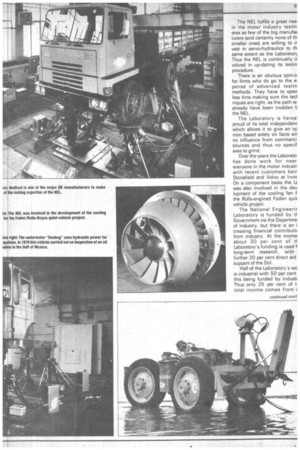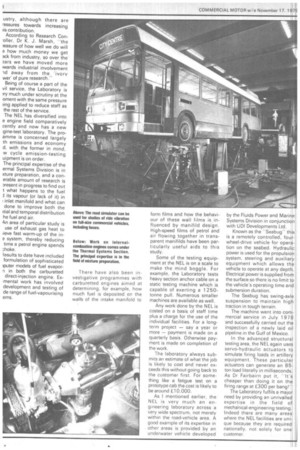A testing time at the Laboratory
Page 68

Page 69

Page 70

If you've noticed an error in this article please click here to report it so we can fix it.
IESEARCH AND DEVELOPIENT in the commercialehicle field is very heavily deendent on testing, be it of Dmponents or complete strucires. As with the components, le testing techniques also need ) be developed.
The National Engineering Thoratory at East Kilbride has uilt up a well-deserved reputean for its expertise in the field f mechanical engineering.
I recently spent a day there liking to members of the 3rious departments about what ley do and why they do it.
The history of the National -igineering Laboratory can beme rather complicated be)use of the number of name nd hence initial) changes in-. Aved. It started about 32 years 3o as the Engineering Division I the National Physical )boratory.
In 1949, the division moved its present site at East Kil-ide, where it was renamed e Mechanical Engineering ?search Organisation (M ER0), was soon changed from rganisation to Laboratory /IERL), finally to be called e National Engineering iboratory.
The NEL covers all aspects ot echanical-engineering search, development and easurement — except the ally specialised areas like the rcraft industry, which has its vn establishment at Fernnough.
Activities carried out at East !bride are divided into 11 ;kills divisions" covering three eas: fluids, manufacturing stems, and materials. The first ea, for example, has divisions thin its framework which MI& flow measurement, fluid echanics and heat transfer. An iportant part of this area is the errnal-systems division where e work on internal-combustion igines is carried out with ecific regard to carburation d lean-burn techniques.
The manufacturing systems aa is involved in automation d robotics, while the materials ea covers all aspects of 3terial behaviour, forming and ri ca tion and service loading. One of the major areas of erest for the vehicle industry in the service loading divisid-n, it is here that work is carried t on ride and durability. The I claims that laboratory test3 has some major advantages er conventional roadand oving-ground testing; the )st significant being the wide riety of known, reproducible )uts which can be applied to the vehicle structure in a laboratory.
For example, a vibration study can be carried out on the road simulator where the entire vehicle is mounted on servohydraulic actuators which then bounce the chassis around, simulating normal road operation. Any input to the vehicle can be used which allows particular resonances to be measured.
Instrumentation and measurement are more easily carried out in a laboratory, and such testing has the added advantages that drivers are not exposed to the discomfort of riding round on the pave and that the vehicle can be inspected visually during testing.
Ride-comfort range
The NEL claims that this sort of laboratory testing makes it easy to measure the natural frequencies of the vehicle in the ride-comfort range over a wide variety of road-surface conditions and speeds.
This road simulator has been used for truck, bus and passenger car development, and both Leyland and Vauxhall/Bedford have been major customers.
The simulators can also be used to fatigue-test parts of the vehicle, like a cab on its chassis. The servo-hydraulic actuators are used to simulate typical pave inputs and are driven by signals which are the result of measurements taken on an actual vehicle on a test track. / This is one of the major difficulties encountered by the NEL staff and is something of a "chicken-and-egg' situation.
Feeding in a typical input to a chassis is comparatively straightforward, but just what is a "typical input"? Thus the hard part is generating these inputs which are to be used in a laboratory simulation.
As many of the current methods of testing rely on computer techniques for data acquisition and analysis, a comprehensive range of computer facilities has been set up to meet the needs of much of the NEL's equipment like the road simulator.
According to Dr J. Fairbairn, head of the service loading division which carries out such investigations, the main function of the NEL is to develop better ways of testing rather than just doing the testing itself. "We need to develop techniques as well as test vehicles." For this, the Laboratory needs a continuous feedback from industry to check that the work is proceeding along the right lines.
The NEL fulfils a great nee, in the motor industry testin
area as few of the big manufat turers (and certainly none of th smaller ones) are willing to ir vest in servo-hydraulics to th same extent as the Laborator) Thus the NEL is continually ir volved in up-dating its testin procedure.
There is an obvious spin-o for firms who do go to the e: pense of advanced testin methods. They have to spen less time making sure the tecl niques are right, as the path w already have been trodden the NEL.
The Laboratory is fiercel proud of its total independent: which allows it to give an ov nion based solely on facts wii no influence from commerci sources and thus no specif axes to grind.
Over the years the Laborato has done work for near everyone in the motor industr with recent customers beir Stonefield and Volvo at Irvin On a component basis the LE was also involved in the dev lopment of the cooling fan f the Rolls-engined Foden quit: vehicle project.
The National Engineerir Laboratory is funded by tt Government via the Departme of Industry, but there is an i creasing financial contributi( from industry. At the mome about 30 per cent of tt Laboratory's funding is used f long-term research, with further 20 per cent direct aid support of the Dol.
Half of the Laboratory's wc is industrial with 50 per cent this being funded by industi Thus only 25 per cent of t total income comes from i
ustry, although there are ,essures towards increasing. is contribution.
According to Research Conoiler, Dr K. J. Marsh, "the leasure of how well we do will e how much money we get Ack from industry, so over the ears we have moved more wards industrial involvement id away from the ivory wet' of pure research.
Being of course a part of the vil service, the Laboratory is ry much under scrutiny at the oment with the same pressure iing applied to reduce staff as the rest of the service.
The NEL has diversified into e engine field comparatively cently and now has a new gine-test laboratory. The proamme is concerned largely th emissions and economy d, with the former in mind, w cycle emission-testing uipment is on order.
The principal expertise of the ermal Systems Division is in xture preparation, and a conerable amount of research is present in progress to find out t what happens to the fuel its vapour (or lack of it) in inlet manifold and what can done to improve both the rtial and temporal distribution he fuel and air.
An area of particular study is use of exhaust gas heat to iieve fast warm-up of the insystem, thereby reducing time a petrol engine spends lesults to date have included formulation of sophisticated iputer models of fuel evapor1 in both the carburetted direct-injection engine. Exmental work has involved development and testing of de range of fuel-vapourising ems.
Therehave also been investigative programmes with carburetted engines aimed at determining, for example, how much fuel is deposited on the walls of the intake manifold to
form films and how the behaviour of these wall films is influenced by manifild design. High-speed films of petrol and air flowing together in transparent manifilds have been particularly useful aids to this study.
Some of the testing equipment at the NEL is on a scale to make the mind boggle. For example, the Laboratory tests heavy section anchor cable on a static testing machine which is capable of exerting a 1250tonne pull. Numerous smaller machines are available as well.
Any work done by the NEL is costed on a basis of staff time plus a charge for the use of the individual facilities. For a longterm project — say a year or more — payment is made on a quarterly basis. Otherwise payment is made on completion of the work.
The laboratory always submits an estimate of what the job is likely to cost andnever exceeds this without going back to the customer first. For something like a fatigue test on a prototype cab the cost is likely to be around £10,000.
As I mentioned earlier, the NEL is very much an engineering laboratory across a very wide spectrum, not merely within the road-vehicle area. A good example of its expertise in other areas is provided by an underwater vehicle developed by the Fluids Power and Marine Systems Division in conjunction with U DI Developments Ltd.
Known as the "Seabug" this is a remotely controlled, fourwheel-drive vehicle for operation on the seabed. Hydraulic power is used for the propulsion system, steering and auxiliary equipment which allows the vehicle to operate at any depth. Electrical power is supplied from the surface so there is no limit to the vehicle's operating time and submersion duration.
The Seabug has swing-axle suspension to maintain high traction in tough terrain.
The machine went into commercial service in July 1978 and successfully carried out the inspection of a newly laid oil pipeline in the Gulf of Mexico.
In the advanced structural testing area, the NEL again uses servo-hydraulic actuators to simulate firing loads in artillery equipment. These particular actuators can generate an 85ton load literally in milliseconds. As Dr Fairbairn put it, "It's cheaper than doing it on the firing range at £300 per bang!"
The Laboratory fulfils a major need by providing an unrivalled expertise in the field of mechanical-engineering testing. Indeed there are many areas where the NEL facilities are unique because they are required nationally, not solely for one customer




























































































































































